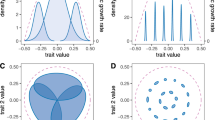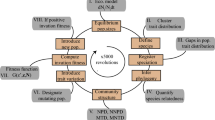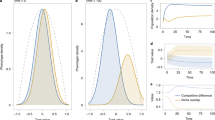Abstract
Ecological communities characteristically contain a wide diversity of species with important functional, economic and aesthetic value. Ecologists have long questioned how this diversity is maintained1,2,3. Classic theory shows that stable coexistence requires competitors to differ in their niches4,5,6; this has motivated numerous investigations of ecological differences presumed to maintain diversity3,6,7,8. That niche differences are key to coexistence, however, has recently been challenged by the neutral theory of biodiversity, which explains coexistence with the equivalence of competitors9. The ensuing controversy has motivated calls for a better understanding of the collective importance of niche differences for the diversity observed in ecological communities10,11. Here we integrate theory and experimentation to show that niche differences collectively stabilize the dynamics of experimental communities of serpentine annual plants. We used field-parameterized population models to develop a null expectation for community dynamics without the stabilizing effects of niche differences. The population growth rates predicted by this null model varied by several orders of magnitude between species, which is sufficient for rapid competitive exclusion. Moreover, after two generations of community change in the field, Shannon diversity was over 50 per cent greater in communities stabilized by niche differences relative to those exhibiting dynamics predicted by the null model. Finally, in an experiment manipulating species’ relative abundances, population growth rates increased when species became rare—the demographic signature of niche differences. Our work thus provides strong evidence that species differences have a critical role in stabilizing species diversity.
This is a preview of subscription content, access via your institution
Access options
Subscribe to this journal
Receive 51 print issues and online access
$199.00 per year
only $3.90 per issue
Buy this article
- Purchase on Springer Link
- Instant access to full article PDF
Prices may be subject to local taxes which are calculated during checkout




Similar content being viewed by others
References
Gause, G. F. The Struggle for Existence (Hafner, 1934)
Hutchinson, G. E. The paradox of the plankton. Am. Nat. 95, 137–145 (1961)
Tilman, D. Resource Competition and Community Structure (Princeton Univ. Press, 1982)
Volterra, V. Fluctuations in the abundance of a species considered mathematically. Nature 118, 558–560 (1926)
Lotka, A. J. The growth of mixed populations: two species competing for a common food supply. J. Wash. Acad. Sci. 22, 461–469 (1932)
MacArthur, R. H. Geographical Ecology: Patterns in the Distribution of Species (Harper & Row, 1972)
McKane, R. B. et al. Resource-based niches provide a basis for plant species diversity and dominance in arctic tundra. Nature 415, 68–71 (2002)
Chase, J. M. & Leibold, M. A. Ecological Niches: Linking Classical and Contemporary Approaches (Univ. Chicago Press, 2003)
Hubbell, S. P. The Unified Neutral Theory of Biodiversity and Biogeography (Princeton Univ. Press, 2001)
Leibold, M. A. & McPeek, M. A. Coexistence of the niche and neutral perspectives in community ecology. Ecology 87, 1399–1410 (2006)
Adler, P. B. HilleRisLambers, J. & Levine, J. M. A niche for neutrality. Ecol. Lett. 10, 95–104 (2007)
Cody, M. L. Niche theory and plant-growth form. Vegetatio 97, 39–55 (1991)
Chesson, P. & Kuang, J. J. The interaction between predation and competition. Nature 456, 235–238 (2008)
Hille Ris Lambers, J., Clark, J. S. & Beckage, B. Density-dependent mortality and the latitudinal gradient in species diversity. Nature 417, 732–735 (2002)
Chesson, P. Mechanisms of maintenance of species diversity. Annu. Rev. Ecol. Syst. 31, 343–366 (2000)
Adler, P. B. HilleRisLambers, J. Kyriakidis, P. C., Guan, Q. & Levine, J. M. Climate variability has a stabilizing effect on coexistence of prairie grasses. Proc. Natl Acad. Sci. USA 103, 12793–12798 (2006)
Harrison, S. Local and regional diversity in a patchy landscape: native, alien, and endemic herbs on serpentine. Ecology 80, 70–80 (1999)
Hobbs, R. J., Yates, S. & Mooney, H. A. Long-term data reveal complex dynamics in grassland in relation to climate and disturbance. Ecol. Monogr. 77, 545–568 (2007)
Watkinson, A. R. Density-dependence in single-species populations of plants. J. Theor. Biol. 83, 345–357 (1980)
Pacala, S. W. Neighborhood models of plant population dynamics. 4. Single-species and multispecies models of annuals with dormant seeds. Am. Nat. 128, 859–878 (1986)
Levine, J. M. & Rees, M. Effects of temporal variability on rare plant persistence in annual systems. Am. Nat. 164, 350–363 (2004)
Levine, J. M. & Adler, P. B. &. HilleRisLambers, J. On testing the role of niche differences in stabilizing coexistence. Funct. Ecol. 22, 934–936 (2008)
Kuang, J. J. & Chesson, P. Coexistence of annual plants: generalist seed predation weakens the storage effect. Ecology 90, 170–182 (2009)
Baskin, C. C. & Baskin, J. M. Seeds: Ecology, Biogeography and Evolution of Dormancy and Germination 19 (Academic, 2001)
Acknowledgements
This work was supported by US National Science Foundation grants 0743365 and 0743183, and a fellowship from the David and Lucile Packard Foundation. P. Adler, C. Briggs, B. Cardinale, P. Chesson, M. Levine, D. Murrell and the Levine and HilleRisLambers laboratories provided comments on the manuscript. C. Cowan, R. Harris and C. Peters conducted the field work.
Author Contributions J.M.L. and J.H. jointly conducted the project, analysed the data and prepared the manuscript.
Author information
Authors and Affiliations
Corresponding authors
Supplementary information
Supplementary Information
This file contains Supplementary Tables 1-2, Supplementary Figures 1-2 with Legends, Supplementary Methods and Supplementary References. (PDF 822 kb)
Rights and permissions
About this article
Cite this article
Levine, J., HilleRisLambers, J. The importance of niches for the maintenance of species diversity. Nature 461, 254–257 (2009). https://doi.org/10.1038/nature08251
Received:
Accepted:
Published:
Issue Date:
DOI: https://doi.org/10.1038/nature08251
This article is cited by
-
Unveiling the transition from niche to dispersal assembly in ecology
Nature (2023)
-
Diel niche partitioning of a plant-hummingbird network in the Atlantic forest of Brazil
Oecologia (2023)
-
Nutrients strengthen density dependence of per-capita growth and mortality rates in the soil bacterial community
Oecologia (2023)
-
Environmental and spatial contributions to tree community assembly across life stages and scales in evergreen-deciduous broadleaf karst forests, southwest China
Journal of Forestry Research (2023)
-
Taxonomic and community composition of epigeal arthropods in monoculture and mixed tree species plantations in a deciduous forest of Ghana
Journal of Forestry Research (2023)
Comments
By submitting a comment you agree to abide by our Terms and Community Guidelines. If you find something abusive or that does not comply with our terms or guidelines please flag it as inappropriate.



